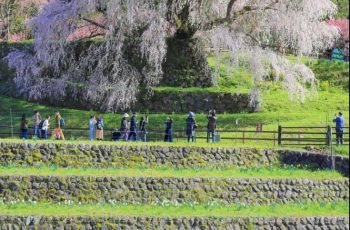Japan is an extraordinary country with unique attractions catering to virtually every taste. For those visiting for the first time, however, the wide variety of services and transport options, not to mention the busy stations and language barrier, can make getting around seem a little daunting. With this in mind, we’ve put together a list of tips that aims to help visitors get the most out of their first trip to Japan.
In this article, we’ll be focusing on one of the most common routes for first-time visitors, which is to start at Narita Airport, explore Tokyo, and then ride the bullet train to Kyoto and Osaka along the Hokkaido Shinkansen. Some of our tips may seem obvious if you’ve been to Japan before, but hopefully even experienced travelers will find some of these useful.
So without further ado, we invite you to follow along as we reveal 15 travel tips for first-time travelers to Japan.
Number one: take advantage of Narita Airport luggage delivery services. Upon arriving at Narita Airport, we recommend dropping heavy or large luggage at one of the airport’s convenient luggage delivery counters. These reliable and, in our opinion, great value services ship your bag anywhere in the country, including hotels, hostels, airports, and private residences.

All you have to do is fill in the address of where you want your luggage to be delivered and then enjoy being bag-free. In some cases, it may be a good idea to inform your lodgings ahead of time, especially if staying at smaller establishments.
Number two: purchase a data SIM or Wi-Fi router before leaving the airport. One of the first things many visitors wish to figure out upon arriving in a foreign country is how to get connected to the internet.

Two common ways to do this in Japan are either with a domestic data SIM card for your smartphone or with a portable Wi-Fi router that can be shared for those traveling in a group. One of the most convenient places to find these is at the airport, where there are numerous shops offering mobile data options. It’s possible with some of these companies to book over the internet in advance and then simply pick up your router or SIM card in the terminal upon arrival.
Number three: buy an IC card. In order to make traveling around Japan as smooth as possible, we recommend purchasing an IC card right away at the beginning of your Japan journey. These cards can be used to ride most modes of transport in virtually all major metropolitan areas across the country and are rechargeable at ticket machines as well as at convenience stores.

What’s more, IC cards can be used as a cashless payment option at a large number of shops and restaurants nationwide, especially in and around train stations. The cards can be purchased easily from the ticket machines at airport train stations with instructions available in English. At the end of your trip, you can return your IC card for a small refund, so be sure to buy your IC card and avoid the inconvenience of having to buy paper tickets for every train journey.
Number four: don’t forget to pick up your rail pass. Train travel is the most common form of public transportation in Japan, and rail passes such as the Japan Rail Pass and others can, depending on your itinerary, make traveling significantly cheaper and more convenient. For those who purchased a rail pass before coming to Japan, the Japan travel service centers, located in the basements of Terminal 1 or Terminal 2 of Narita Airport, are the first place where you can pick up your pass upon landing.

Number five: getting from Narita Airport to central Tokyo. There are a number of ways to get from Narita Airport to central Tokyo, and the best option depends on two things—where in Tokyo you are going and your budget. For those willing to spend a little more to arrive in central Tokyo faster, the Narita Express and Keisei Skyliner both provide quick ways to get to central Tokyo by train, making the direct journey to Tokyo Station and Ueno Station respectively before stopping at other major downtown stations.

Slower, cheaper train options include the regular Keisei Limited Express trains. There are also two main types of bus from Narita Airport to Tokyo: the expensive airport limousines, which stop at a number of stations and hotels in central Tokyo, and cheaper discount shuttle buses which connect to fewer places. Taxis can also be used to reach central Tokyo, but bear in mind that this is by far the most expensive option.
Number six: find the best type of accommodation in Tokyo. Tokyo is an extremely diverse metropolis, and this is reflected in the multitude of accommodation options available to visitors. Of course, there are the usual range of hotels to suit all budgets and other accommodation types that one would expect to find in any major city. However, Tokyo also contains a variety of unique options that travelers may want to take advantage of, including capsule hotels, quality hostels, internet cafes, and historic yet affordable traditional ryokan.

Number seven: buy Shinkansen tickets via a smartphone app. In order to save time at the station, it can be a good idea to purchase Shinkansen tickets ahead of time using the SmartEX app, which is available in English and boasts a user-friendly interface. In order to take advantage of SmartEX, follow these steps: 1. Purchase an IC card. 2. Install the app. 3. Register your credit card. 4. Connect your IC card to the app by inputting the ID number on the card. 5. Book your Shinkansen. 6. Use the associated IC card to tap through the ticket gates at any Shinkansen station between Tokyo and Hakata.

And don’t forget to pick up the ticket that comes out the other side. Bear in mind that there are three seat types available on the Shinkansen, including reserved, unreserved, and the more luxurious seats in the green car.
Number eight: navigate Tokyo Station. Tokyo Station is large and can be confusing even for those who use it regularly. Upon arriving, follow signs for the Tokyo Shinkansen and then enter the ticket gates. From here, there will be more signage helping you locate the correct platform and line up for the right car number. For those who don’t have a ticket yet, they can be purchased before entering the Shinkansen gates at either a ticket machine or from the ticket counter.

Number nine: purchase an ekiben before boarding the Shinkansen. We recommend making the most out of Tokyo Station’s good quality food options and purchasing an ekiben from one of the shops or kiosks that can be found around the station or even on train platforms. An ekiben—short for eki bento, or station lunchbox—are a popular meal in Japan for those on the go.
They are typically comprised of regional or seasonal specialty foods and presented in a decorative box or sealed platter. Delicious and generally good quality, ekiben vary station to station and are great to enjoy during your cross-country travels.
Number ten: storing bags and luggage on the Shinkansen. If you have luggage, one of the biggest concerns is where to store it on the train. Thankfully, the Shinkansen has space for suitcases and bags in several locations throughout the car. Smaller bags like backpacks and day bags can be stored on the overhead shelves, and there is also a larger space behind the last row of seats in each car.
Number eleven: using the toilets on Shinkansen and in train stations. Japan is known as one of the most hygiene-conscious countries in the world, and this certainly extends not only to the restrooms within train stations but also on the Shinkansen—all of which are free of charge. This means that you don’t have to worry if you miss your chance to freshen up before boarding. Shinkansen restrooms are clean and located between every couple of cars, so locating them once aboard is quick and easy.

Number twelve: take advantage of the Shinkansen’s selection of amenities. Bullet trains boast a selection of amenities that make traveling on them comfortable and convenient. For example, if your mobile device’s battery is about to die, many seats have power outlets nearby. In case you get hungry, there are also food carts that intermittently make the rounds of the cars, from which snacks and drinks—from coffee to beer—can be purchased for reasonable prices.
Number thirteen: enjoy a view of Mount Fuji from the Shinkansen. Many passengers don’t realize that on a clear day, Mount Fuji can be seen from aboard the Tokaido Shinkansen. The window seat on the side that faces Mount Fuji—seat E or seat D in green class—is where the best unobstructed views can be had of Japan’s most famous natural icon. So make sure while making seat reservations to reserve seat E if possible. If you happen not to be able to sit in this coveted spot, it is also possible to see Mount Fuji by standing between the cars and looking out of the window.

Number fourteen: know what to do with your luggage upon arriving at your destination. Many major train stations boast luggage storage and delivery services. And for those who didn’t get their luggage delivered from Narita Airport, now might be a good time to have large or inconvenient baggage delivered quickly and easily to your hotel. Alternatively, for those continuing on to immediately do a side trip before returning, there are various luggage storage facilities, including coin lockers, which in many major stations are compatible with IC cards.
Number fifteen: know how to get your money. The first opportunity to access your money upon landing is at the currency exchange facilities in the arrival lobby of airports. After that, many banks and convenience stores across Japan have ATMs. However, it can be hit or miss if these machines accept your specific international card. Fortunately, all post offices nationwide—even in remote areas—as well as all 7-Eleven and many other convenience stores have ATMs that are compatible with foreign cards.
Of course, there are nearly an endless number of tips, but hopefully these will enable you to get more out of your first trip to Japan. For more information or to watch another video, click the links on the screen now or head over to Japan-Guide.com—your comprehensive, up-to-date travel guide first-hand from Japan. Thanks for watching and be sure to subscribe and click the notification bell for more videos about Japan.

